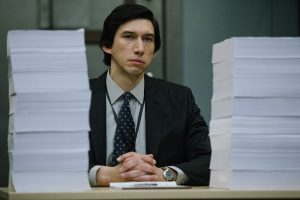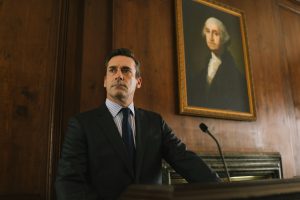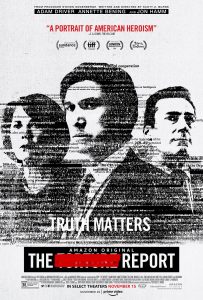‘The Report’ chronicles the heroic pursuit of an ugly truth
“The Report” (2019). Cast: Adam Driver, Annette Bening, Corey Stoll, Jon Hamm, Maura Tierney, Michael C. Hall, Tim Blake Nelson, Linda Powell, Victor Slezak, Scott Shepherd, John Rothman, Ted Levine, Douglas Hodge, T. Ryder Smith, Fajer Kaisi, Zuhdi Boueri, Ratnesh Dubey, Carlos Gómez, Pun Bandhu, Joanne Tucker, Ian Blackman, Damian Fumusa, Joseph Siravo, Jennifer Morrison, Alexander Chaplin, Evander Duck Jr., Matthew Rhys. Archive Footage: Barack Obama, Dick Cheney, Donald Rumsfeld, John McCain, John Kerry. Director: Scott Z. Burns. Screenplay: Scott Z. Burns. Story: Katherine Eban, “Rohrschach and Awe,” Vanity Fair magazine, July 2007 (uncredited). Web site. Trailer.
Exposing a painful truth is never easy. That’s especially the case when those who have much to lose hinder the process by nefariously intentional interference to conceal its ugly revelations. Thankfully, though, there are those who are staunchly committed to seeing that justice, honesty and integrity are served, a quest detailed in the riveting new historical drama, “The Report.”
Things changed considerably for many individuals and institutions in the wake of the 9/11 terrorist attacks. For Daniel J. Jones (Adam Driver), that meant an alteration in his career path. He felt a need to become involved in something that would make a difference in the aftermath of that horrendous day, so he sought work in the intelligence field. He spent several years amassing experience with the FBI before becoming a Senate staffer working for Sen. Dianne Feinstein (D-CA) (Annette Bening). In this new capacity, Jones was charged with investigating the government’s Enhanced Interrogation Techniques (EIT) program, a controversial initiative implemented by the Bush Administration to use new methods for drawing out information from suspected terrorists.
Through a series of flashbacks, the genesis of the EIT program is detailed to illustrate what Jones was assigned to investigate. Viewers witness examples of such techniques as waterboarding, extreme sleep deprivation and even simulated coffin burials that government officials employed in hopes of extracting vital information about terrorist organizations and their plans for possible future attacks. However, given the questionable techniques used, it became widely apparent that they constituted torture, going beyond what were generally considered acceptable interrogation practices, measures seen as unacceptable for a nation that claimed to represent itself as the pinnacle of justice and fair treatment of prisoners.

Fearless and idealistic crusaders Sen. Dianne Feinstein (D-CA) (Annette Bening, left) and Senate staffer Daniel J. Jones (Adam Driver, right) seek to expose the dark secrets of the CIA’s Enhanced Interrogation Techniques (EIT) program in the wake of the 9/11 terrorist attacks in the gripping new fact-based political thriller, “The Report.” Photo by Atsushi Nishjima, courtesy of Amazon Studios.
But the severity of the treatment was not the only problem. Due to the intensity of the techniques and the perceived need to repeat them – sometimes as many as 186 times – to draw out crucial information, it became an expensive program, especially given the many suspects who were apprehended and interrogated. Even more distressing, though, was the fact that the techniques didn’t work; suspects ended up saying anything to get the torture to stop, which meant that government officials were being told lies or were being supplied with information already in their possession. The suspects themselves often weren’t who they were believed to be, and, even if they were involved with terrorist groups, they were usually low-level participants, far from the big players the government thought it had captured. (So much for the effectiveness of a supposedly “better” approach.)
Jones, who initially believed that the government should do whatever it could to keep the public safe, gradually had a change of heart the further he got into his investigation. He came to see the fiscal waste, the inhumane treatment and the undeniable ineffectiveness of the program up close and in great detail. While many in the Bush Administration saw it as an essential element of its antiterrorism efforts, Jones and Feinstein came to realize it was nothing more than a huge, expensive embarrassment for the nation, one that didn’t yield any new or meaningful intelligence – and that ultimately didn’t prevent any of the alleged attacks that were supposedly in the works. Even the eventual capture of alleged 9/11 mastermind Osama bin-Laden came about as a result of information derived from sources other than those subjected to the EIT program.
Amassing these findings wasn’t easy, either. The CIA, the driving force behind the EIT program, was less than cooperative, implementing measures that hindered the investigation. For instance, the agency refused to allow its staff members to be interviewed. Thus, to get the information he needed, Jones was forced into sorting through voluminous emails and other archived communications, a tedious and time-consuming process for someone with limited staff to assist him. What’s more, all of this work had to be conducted at a clandestine CIA facility from which nothing could be removed under penalty of prosecution.
Understandably, Jones became frustrated by the process, especially when he uncovered increasingly damning evidence about the program. Opposition from the intelligence community, backed by sympathetic (some would say collaborative) parties within other branches of government (including Congress), stifled Jones’s efforts. In addition, to dilute and counter whatever credibility he was beginning to develop, those seeking to protect the program made sure its supposed accomplishments were sufficiently trumpeted in the media, a move aimed at solidifying public support. This even became evident through entertainment vehicles like the film “Zero Dark Thirty” (2012), a Hollywood production detailing the “official” events involved in the raid on bin-Laden’s secret compound in Pakistan.

Having written a nearly 7,000-page report about the dark secrets of the CIA’s Enhanced Interrogation Techniques (EIT) program, Senate staffer Daniel J. Jones (Adam Driver) struggles to get the document released in the face of strong opposition in director Scott Z. Burns’s new political thriller, “The Report.” Photo by Atsushi Nishjima, courtesy of Amazon Studios.
For Jones, this exercise was an eye-opener. As someone who initially firmly believed in the government’s official efforts, he gradually became disillusioned, even angry, at what he found. Keeping his composure in light of his mission became increasingly difficult, especially when attempts at preventing his findings from being revealed were ramped up and officially sanctioned by members of Congress. Such was the case not only during the Republican administration of George W. Bush but also during what was seen as the supposedly friendlier Democratic administration of Barack Obama. These increasingly onerous obstacles eventually drove Jones to consider actions that placed his own career in jeopardy in order to make the truth known. He risked the possibility of prosecution for his ideals – and those of what he believed were the nation’s as well.
Fortunately, throughout this process, Jones had Feinstein’s backing, a fierce level of support that gave him what he needed but that simultaneously threatened to damage her own clout and credibility. Nevertheless, Jones and Feinstein were committed to releasing their nearly 7,000-page report, a battle that pitted them against powerful Washington influences and prompted them to seek the assistance of some seemingly unlikely allies, including those on the other side of the political aisle. To them, the truth was more important than any potentially embarrassing consequences that might emerge from these revelations. But, then, for a nation that claims to stand as a shining example of democracy for the world, this was seen as essential to minimize the damage wrought by the questionable deeds and blatant hypocrisy that led them to this point.
The 9/11 tragedy took so many of us by surprise that we were unsure how to react. Some were afraid and desperately wanted security. But not everyone was in agreement on how to go about attaining it. Many sought safety while preserving justice. Others, however, pursued protection at any cost, even if that meant resorting to vengeful and questionable tactics. Admittedly, this was new territory for virtually everyone, so coming to consensus on how to proceed was far from easy, especially on what approaches to employ. The differences among us were driven by our individual beliefs, and that’s significant, for they dictate how events unfold, the result of what happens through the conscious creation process, the philosophy that maintains we draw upon those notions in manifesting the reality we experience. And, as this film shows, the variances in beliefs were great, a disparity that accounted for the diverse outcomes that resulted while addressing the aforementioned need for security.
Many Americans wanted to be safe but to achieve that security through tough but fair and just means. That’s exemplified here by Jones’s sincere idealism. However, there were also those who believed in attaining protection by any means possible, even if by unapologetically tapping into more ruthless tactics driven by qualities like vengeance and vindictiveness. And that outlook is apparent here in the attitudes and practices of those in power, those who, at least initially, wielded the greatest and most readily deployable reserves of metaphysical and tangible resources needed for effectively and clandestinely carrying out such plans. Those methods were artfully clothed in zealous, patriotic rhetoric designed to cultivate the support of a wary but grateful public that was intentionally shielded from knowing the truth about what was really going on. Had citizens known what their elected officials were really up to – and how their tax dollars were being spent – they may not have been so willing to give their leaders a blank check to provide them with the security they sought, especially since that protection didn’t come about as a result of those questionable tactics in the first place.

Risking her reputation to fight for the release of a document critical of the intelligence community, Sen. Dianne Feinstein (D-CA) (Golden Globe Award best supporting actress nominee Annette Bening) stands her ground in the face of significant opposition in “The Report,” now available for streaming on Amazon.com. Photo by Atsushi Nishjima, courtesy of Amazon Studios.
This is where the work of Jones and Feinstein became so important. They sought to expose the deception, the atrocities and the waste involved in the EIT program. They believed in providing security to the public, to be sure, but they also believed in upholding the principles that the country claimed to stand for in achieving that goal.
Jones and Feinstein faced many obstacles in bringing that information to light, but they had something going for them in their beliefs that their opponents didn’t – integrity. They were being honest with themselves and their constituents in how and why they went after the evidence they sought. They believed in being above board and making sure their investigation and its findings reflected that. Their results bore that out, too.
Meanwhile, those who developed and implemented the EIT program ultimately failed because it arose out of beliefs and assertions that were innately short on integrity. On some level, they knew their tactics didn’t align with the ideals that America stood for, even if they tried using the terrorist threat to “justify” what they were doing. It probably had something to do with why they also fiercely tried to keep information about the program under wraps, rationalizing their efforts as being in the interests of national security, even though that undertaking probably had more to do with keeping their merciless practices from seeing the light of day. But, then, those outcomes shouldn’t come as any surprise from a plan that arose from beliefs based on a fundamental lack of integrity to begin with.
Even if the developers of the EIT program were to believe in the validity of what they were doing, their efforts nevertheless reflect the practice of un-conscious creation or creation by default. This occurs when we are so focused on using our beliefs to attain a particular goal that we give no credence to the consequences that can result from our efforts. By paying no attention to the fallout that can come from implementing a particular initiative, we run the risk of overlooking, and subsequently experiencing, all manner of unintended side effects. Those behind the program no doubt discovered that when one of their subjects died as a result of their practices, an outcome that they were convinced couldn’t happen. Yet, when their victim ended up succumbing to the injuries they inflicted upon him, he was nevertheless dead, despite supposed assurances to the contrary.
Given what Jones and Feinstein were up against, making meaningful progress required some creative thinking. First, they had to overcome whatever fears they might have had. Considering that they were facing the considerable power of the intelligence community, it’s not too hard to believe that they could have easily been intimidated. It was essential that the investigators dispense with any fear-based beliefs that might hold them back. That meant embracing courageous and heroic perspectives as they proceeded in their efforts.

Denis McDonough (Jon Hamm), Chief of Staff to President Barack Obama, walks a tightrope to accommodate the needs of those with differing political agendas in the new fact-based drama, “The Report.” Photo by Atsushi Nishjima, courtesy of Amazon Studios.
Then there was the need to become innovative in their thinking. Given the expert manipulative prowess of intelligence operatives, Jones and Feinstein faced the real possibility of being deceived, misdirected and stonewalled in their work. This thus called for employing inventive strategies and practices, such as drawing upon the information embedded in agency emails and cables in lieu of evidence gleaned from in-person interviews with those who participated in the program. They also drew heavily upon information online, some of which was surprisingly revelatory (perhaps even to the CIA itself). These approaches may have been more time-consuming and arduous, but they nevertheless yielded vast veins on intelligence gold – material that, had it not surfaced, wouldn’t have given the investigators what they needed to prepare their report.
The same was true when government insiders tried to block the release of Jones’s report, an initiative driven largely by partisan considerations. To counter this, Feinstein saw the need to step across the political aisle and recruit Republican support, an effort that earned her the backing of Sen John McCain (R-AZ). With the investigation now receiving bipartisan support – especially with that of two highly influential Senators from different political camps – opponents of the release of its findings found it more difficult to find friends who would give them and the program unlimited cover.
Most of all, though, the work of Jones and Feinstein reveals their commitment to their personal value fulfillment, the conscious creation concept associated with being their best, truest selves for the betterment of themselves and the world at large. The investigators were dedicated to exposing the truth about the EIT program, even in the face of potentially high political and career costs. They were convinced that it was the right thing to do, no matter how challenging, and they pursued it with unflinching zeal, even when the going got tough. Those who claim to call themselves true defenders of American ideals should thank them for what they did – for exposing an ugly and hypocritical incident in our nation’s history and making a betrayed public aware of what really went on.
This meticulously detailed, methodically explained history of the efforts to prepare the controversial Senate report is one of the year’s most underrated offerings. Its excellent performances by Driver, Golden Globe Award nominee Annette Bening and a fine ensemble of supporting players enliven a story that otherwise could have been potentially tedious. The picture’s razor-sharp script not only delivers the facts, but it does so with edgy wit and just the right amount of cynicism to expose the true nature of what was really going on during a turbulent period in the nation’s history, when ethics were placed on the chopping block in favor of expediency and the fulfillment of dubious agendas. It’s a smart, savvy, eye-opening offering that every truly loyal American should see.

Unfortunately, “The Report” has not received the notoriety and attention it deserves. The movie played the film festival circuit during the fall, followed by a limited (and all-too-brief) theatrical run. Thankfully, though, the picture is now available for streaming on Amazon.com.
For all of the Daniel Joneses of the world, there are those who would willingly do just the opposite of what he sought to accomplish. That’s unfortunate, too, for every scandal and misdeed that remains unexposed hurts us all in the long run. Given that, we can only hope that the courageous crusaders among us find the wherewithal – and the support – to step up and pursue their destiny, to shed light on the darkness and make it apparent for all to see. That’s truly heroic, a quest to which we should all aspire.
Copyright © 2019, by Brent Marchant. All rights reserved.




Leave A Comment